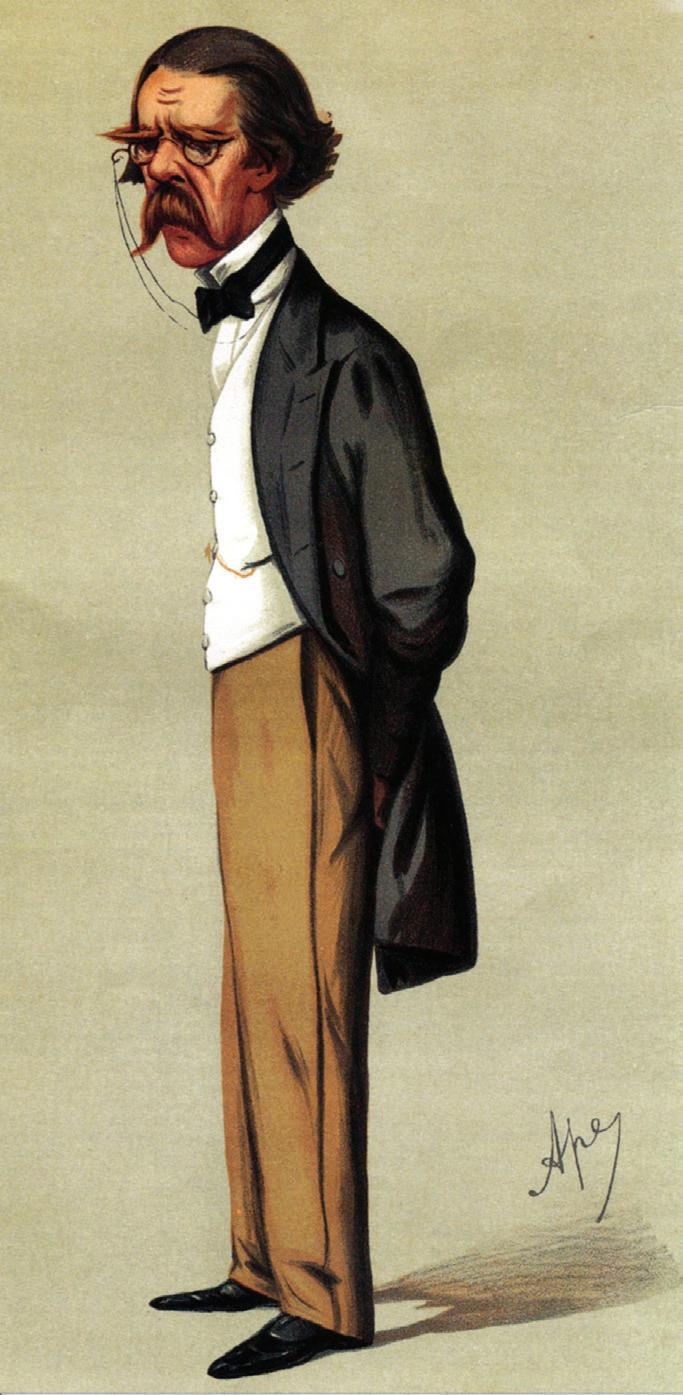
12 minute read
The surgeons of Vanity Fair magazine: Sir Henry Thompson
Sir Henry Thompson, the versatile Victorian
The surgeons of Vanity Fair part three
Advertisement
Sir Henry Thompson was Vanity Fair’s 85th ‘Man of the Day’ on 1 August 1874: his accompanying caricature by Carlo Pellegrini, ‘Ape’, was captioned Cremation. The accompanying notes helpfully note that, “he has more recently advocated cremation as a better method of disposing of the dead than that now in vogue”. The likeness captured, matching a firsthand description in 1878, “as a distinguished slender middle-aged man
with hair untouched with grey, great bushy eyebrows bristling over dark brown eyes, a full moustache, and a lithe active frame.” Thompson was born at Framlingham, Suffolk, on 6 August 1820. He was the son of a nonconformist, a businessman with rather narrow convictions, who objected to his son studying medicine because he thought the necessary studies might pervert his religious faith. Henry was thus engaged in commercial activities until he was 27 years old; his health steadily deteriorated until his father eventually allowed him to enter medicine. In October 1846, he visited the University College in London, which had been founded in 1826 as a secular alternative to Oxford and Cambridge, and, in January 1847, commenced his medical career there. He never went to a public school and received all his education privately; however, Thompson’s general knowledge suffered little from this and he had a good grounding in the classics and a considerable amount of elementary science. He was the only boy in the family and for 10 years the only child. His mother, Susannah Medley, was the eldest daughter of Samuel Medley, artist, and Thompson inherited his artistic capabilities, finding during his medical studies his ability to draw useful. He later found painting to be a great relief from his surgical work. Over time he had no less than 13 paintings hung at the Royal Academy. He won the gold medal in anatomy in 1849 and surgery in 1851, gaining the Membership of the Royal College of
The Versatile Victorian by Zachary Cope dustjacket.
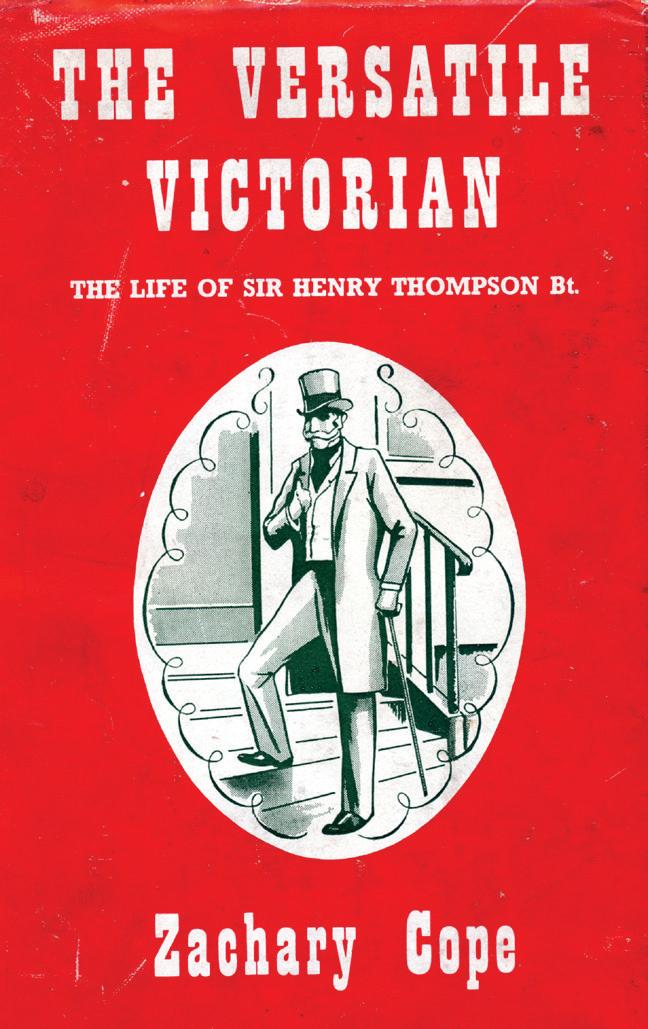
Surgeons (MRCS) in 1850, M.B. Lond. in 1853 and Fellowship of the Royal College of Surgeons (FRCS) later that year. In February 1850, he met Kate Loder, a brilliant young pianist, and before long Thompson realised that he had found someone he could both love and admire. They married in December 1851. Thompson then noticed that the Royal College of Surgeons was offering the Jacksonian Prize for the best essay on ‘Stricture’, and that all manuscripts, drawings or pathological specimens were required by 31 December 1852. Thompson spent most of the first year of his marriage preparing material to submit for the prize, ultimately proving successful in April 1853 when he received his cheque for 20 guineas (£21) from the
Above l-r: Thompson's modified lithotrite 1860s, Thompson's first novel 1885; Motoring handbook written by 82-year-old Thompson.

president. This work was published as The Pathology and Treatment of Stricture of the Urethra. Urological progress owes most to the French. In 1824, Jean Civiale created a urological service in Paris, where Thompson was to study, later modifying Civiale’s lithotrite and bringing the operation of lithotrity to perfection. He pioneered a revival in suprapubic cystotomy and was the very first to remove a growth from the urinary bladder. Though Thompson practised general surgery for a short time he soon limited his work to urinary surgery and became the first specialist in urinary diseases in England. Vanity Fair opined, “with a hardhead, a great love of the positive and an equal distrust of the speculative, he naturally devoted himself to the carving branch of the healing art … addressing himself more especially to the study of some of the most despised organs of the human frame.” He was self-confident. “Sir,” he once said to a patient as he lay on the couch, “you have a stone in the bladder”. “That is impossible,” replied the patient. “I have been assured by a very rising surgeon that there is nothing of the kind present.” “Sir, I have risen,” was Thompson’s crushing reply. For the greater part of his life Thompson was a keen traveller, and as his practice flourished he began a series of continental holidays. This tradition continued for 30 years with 26 such holidays during that time, in addition to professional visits made to patients in Belgium, France and Italy. Thompson was a prolific writer from his youth onwards. He published no less than 22 books, comprising surgical texts
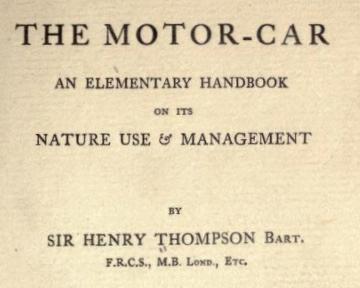
related to diseases of the lower urinary tract, as well as cremation, Qing dynasty porcelain. He also published Moderate Drinking, Food and Feeding and, in 1902, The Motor-Car: an elementary handbook on its nature, use & management. Regarding cremation he wrote, “I had long believed that cremation was in theory the quickest and safest mode of reducing the dead body to its original elements – the end attained slowly and not without danger to the living, by burial in earth.” Thompson also wrote novels under the pseudonym of ‘Pen Oliver’. His first novel, Charley Kingston’s Aunt, was published in 1885, achieving 15 editions in 18 months. Charley Kingston was a medical student who, while dissecting, thought the face of the subject was familiar. He suddenly realised, “Good heavens the old aunt!” The subject was his wealthy aunt who had gone to America a few years previously and having returned, lost her memory after a stroke. She died in the Marylebone Infirmary, friendless. Charley sees that his aunt is buried decently and, in so doing, obtains a considerable share of the money she left! In 1880, Thompson purchased Hurstside, a property near Hampton Court Palace, both as a country retreat and to commence poultry farming and market gardening. By 1883, the Live Stock Journal declared his poultry yard as the best in England, only for Thompson to abandon the whole enterprise the following year. The reason was that poultry shows were judged on the external characters of birds, not as table produce. His interest in astronomy led him to build an observatory there in 1886, utilising part of the poultry house. Once again, his enthusiasm waned, and by 1889 he disposed of the installation “and all the valuable contents at a considerable sacrifice”. Nevertheless, in 1897, he
Above from top: Octave dinner scene, from left, facing one: Quain, Paget and Thompson; Thompson at 80 years old.
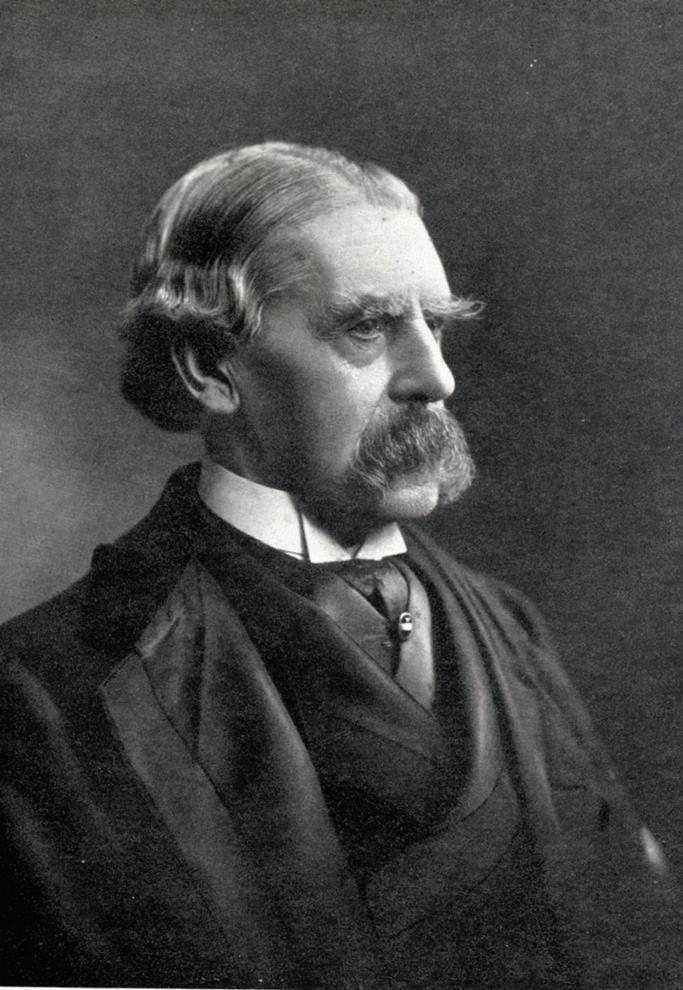
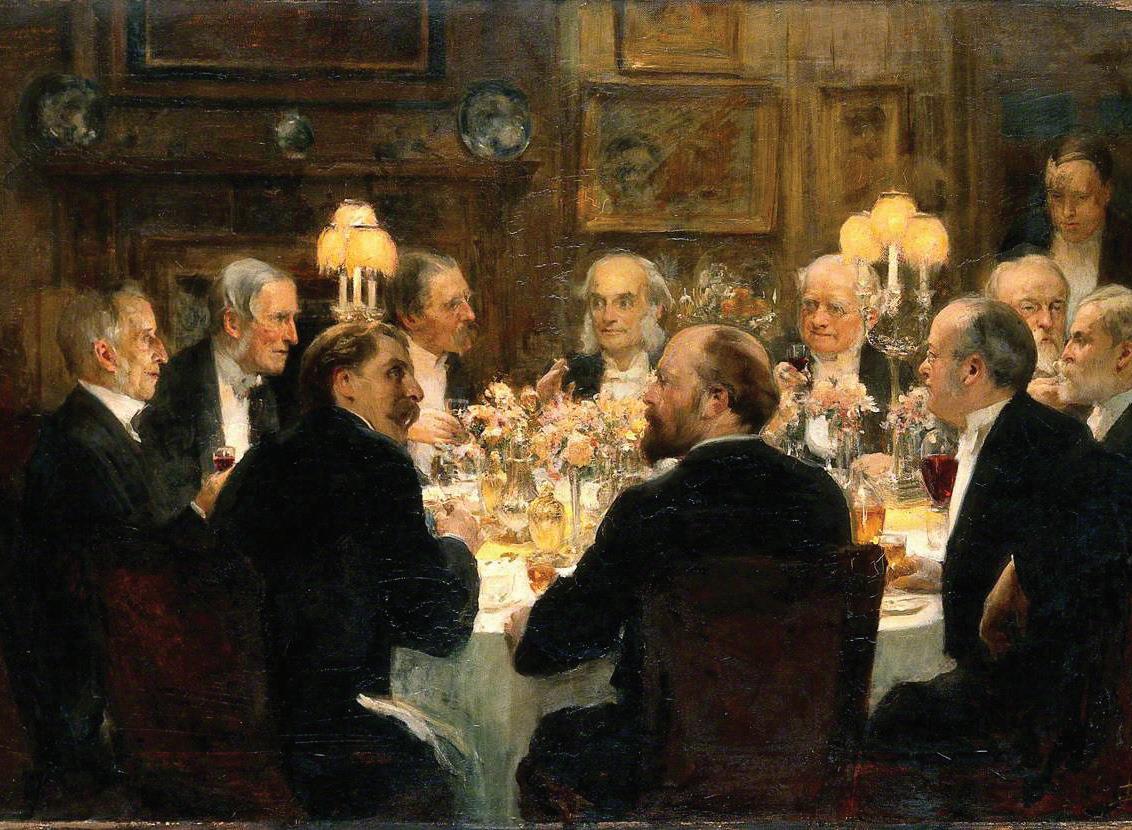
presented the Royal Observatory at Greenwich with a large photographic telescope at a cost of more than £5000. Thompson had been knighted in 1867 and as the Encyclopaedia Britannica noted he received a baronetcy in 1899, “probably not unconnected with the presentation.” At age 70 he took up photography instead of sketching, utilising a special twin camera equipped with special lenses. He was famous for his ‘Octaves’, dinners for eight male guests, which began in 1872 and continued until 1904, the last one occurring shortly before his death. Thompson took it upon himself to bring together men of different professions, men engaged in art, literature and politics, at small and well-selected parties. To be invited was a distinction. There were eight courses and eight wines, the meal commencing at 8pm, where seated at a round or oval table the group could, if needed, discuss a single topic of conversation when one naturally arose. He was a typical Victorian with vigorous intellectual activity and a capacity for intense hard work, rendering him always inquisitive and curious. His many diverse interests were well summarised in the Punch magazine in 1881. Thompson died peacefully, aged 83, three days after his last motor drive, at his London home. His body was cremated at Golders Green crematorium. He left one son and two daughters, predeceasing his wife. His death notice in The Times occupied three and a half columns, reflecting the replete life of a very versatile gentleman. Mr Peter F. Burke FRACS
IMAGE REFERENCES
Page 50: Pellegrini C. New York. Vanity Fair; 1874. Public Domain. Henry Thompson caricature ‘Cremation’ caricature. Page 51: Thompson H. Charley Kingston’s Aunt: A Study of Medical Life and Experience. London. F. Warne and Co.; 1893. Dustjacket of book; Thompson H. The Motor-Car: An Elementary Handbook on its Nature Use and Management. London. F. Warne and Co.; 1902. Title page Page 52: Solomon JS. An Octave for Mr Ernest Hart at Sir Henry Thompson’s House. London. Wellcome Library; 1897. Licensed under Creative Commons CC BY (3.0. Unported); Millais JE. Sir Henry Thompson Bt. London. Tate; 1881. Licensed under Creative Commons CC-BY-NC-ND (3.0 Unported).
Medicine and law: two professions, one common language?
This topic was raised by a distinguished surgeon at a meeting of the Australian Medico-Legal College in Sydney, in December 2018. Despite inclination towards an affirmative reply, his decision was not definitive. My views are in definite opposition. While this is an intriguing philosophical and ethical topic, I base my view as negative due to the vastly different ethics, duties and interests of the two professions. My impressions are formed by reading and experiences. The duties of physicians were set out in the early 16th century by the great humanist Erasmus of Rotterdam (1466–1536). Erasmus was the son of a priest in Brabant and he received an extensive education, mostly ecclesiastical. Ordained but excused from preaching due to ill health, Erasmus wrote on theology, philology, education, history, politics and morality. His exceptional ideas were collected in 24 volumes that can still be found in today’s university libraries. This humanist remained aloof from all church reformers seeking his support, as well as separated from all monarchs and pontiffs seeking his advice. He remained faithful, and protected the institution of the Church, stating, “do not condemn the church for a few monks being murderers.” His views on healers were expressed in his ‘Oration in praise of the art of medicine’ (1518), dedicated to his physician. In it he enumerated the well-known duties of a physician: 1. Erasmus reminded the reader of the physician’s duty to save lives, or at least ameliorate suffering, irrespective of any other interest. “The majesty of civil law and the authority of the common law are voluntarily submitted
to the medical one, and that medicine has a role of an independent authority assisting theological and judicial deliberation.” He stated that health outcomes are determined partly by birth (i.e. DNA?) and also mentioned exercise, nutrition and even housing as factors. 2. Erasmus reminded physicians of the need to keep up with medical developments, and apply them with diligence, being aware of “new strains of diseases” and “daily hazards”, that is to say, the requirement for continuous study. 3. Erasmus stated that a duty of the physician is to be a friend to the patient, while also expecting financial reward. He said, “does not a man who by his professional skill holds imminent death at bay, who restores life when it has been suddenly assailed by disease, forever deserves to be treated as if he were some beneficial propitious being?” These duties are enshrined within the rules of the Royal Australasian College of Surgeons and the Australian Medical Association, and to these all doctors must comply. In opposition I present Niccolò Machiavelli (1469–1527), a contemporary intellectual who was a notary to the Florentine government, diplomat, writer and historian. His name became acknowledged in the dictionary as Machiavellian: “placing expediency above political morality, and countenancing the use of craft and deceit in order to maintain the authority and effect the purposes of the ruler.” From my own experience I quote three examples: 1. In consulting a patient for medico-legal purposes, the patient attended with no X-rays, at the advice of his legal representative. This was done so as
“not to confuse the doctor”. Was the lawyer afraid that the doctor might reinterpret the report supporting the patient’s claim and find a different diagnosis? 2. A patient with a forearm fracture and a slight deviation had refused in writing the surgical reposition offered, and was accordingly treated conservatively.
Nonetheless, several months later she was operated on by another surgeon.
The unhappy patient turned to a lawyer who suggested sueing both surgeons.
The case was settled with minuscule reward for the patient, and a double reward for the lawyer acting against the two surgeons, against the wishes of both surgeons involved. 3. The third example is perhaps the most morally condemnable one. A 27-year-old suffered a steering wheel compression, with signs of myocardial infarct. He was taken to hospital unconscious and was diagnosed with ventricular fibrillation. He was fully resuscitated, a stent was inserted and he was looking for work a year later.
When he sought legal advice, he was advised to sue the hospital that saved his life. Recalling these three cases, one may question how these two professions, with such different ethical values and interests, can have a common language?
Dr George M Weisz, FRACS Adjunct Associate Professor, School of Humanities UNE and Adjunct Senior Lecturer, School of Humanities, UNSW
Surgical oncology is an area of specialisation that is often misunderstood by the general public and sometimes the medical profession itself. Surgical oncologists can be from any surgical subspecialty and are involved in cancer care through clinical practice, research, advocacy and education. Surgical oncologists are frequently the first specialist a patient sees after a cancer diagnosis. They can manage a large multidisciplinary, team but are often perceived as a technician directed by others. RACS’ Surgical Oncology Section aims to raise awareness of the role of surgeons in cancer care, advocate on their behalf and, through innovation and research, improve cancer outcomes. The RACS Surgical Oncology Section celebrates its 21st birthday this year with a new committee. Chair Associate Professor Michael Hughes said that
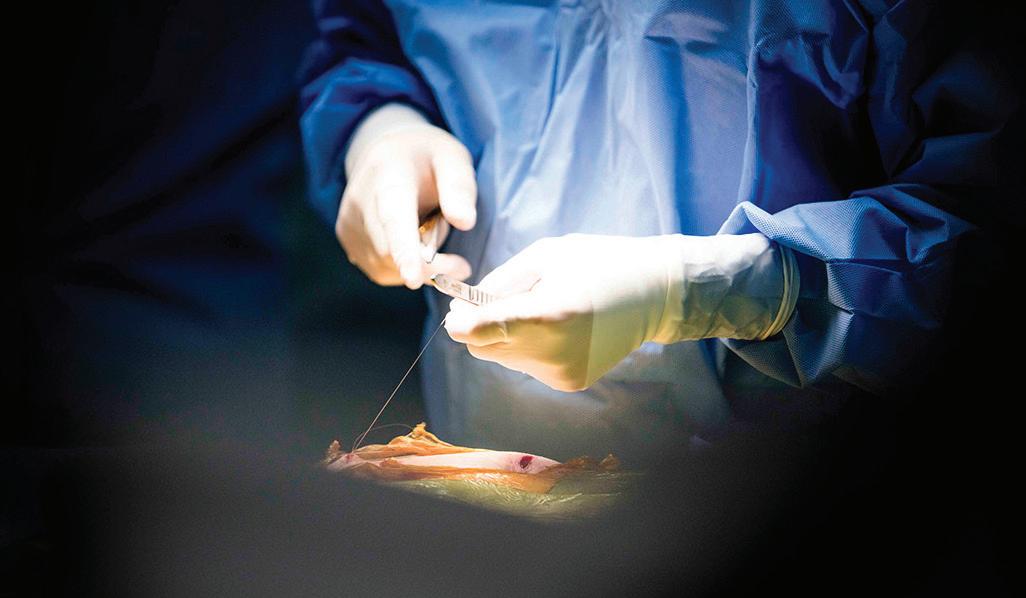
having a solid foundation in place puts the section in a strong position to make a real difference. Associate Professor Hughes is proud that the section pulls together members from most specialties and subspecialties, as is reflected in the committee. The vision of the section is a clear one: to represent, support and advance cancer surgery and cancer surgeons across Australia and New Zealand. Having a space to collaborate affords the section a united voice with which to advocate on general issues surrounding cancer care more effectively, and to improve visibility for surgical oncology and outcomes for patients. The section provides an opportunity for interdisciplinary discussion and sharing of ideas that may not otherwise occur. Associate Professor Hughes explains how general surgeons with expertise, in areas such as skin cancer, can engage with Fellows in Plastic and Reconstructive surgery. The collaboration and sharing of ideas are not limited to between Australian and New Zealand specialties but extend internationally, recognising that through connection with others, real understanding and action can be achieved. Surgical Oncology Section membership is open to all Fellows, Trainees and Specialist International Medical Graduates on the pathway to Fellowship. Join now by logging into the RACS website, selecting the Portfolio followed by your Profile tab. Go to the ‘Sections’ tab and select Surgical Oncology or email the secretariat: surgical.oncology@surgeons.org







